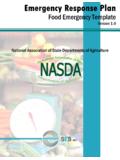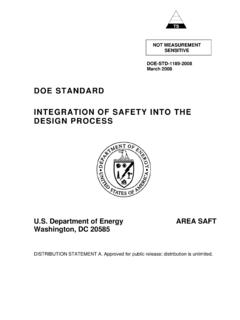Transcription of Types of Disasters - World Health Organization
1 1 FETPAFI1 Types of DisasterTypes of DisasterNEC - DOHFETPAFI2 DisasterDisasterAn event that occur when significant number of people are exposed to hazards to which they are vulnerable, with resulting injury and loss of life often combined with damage to of DisasterTypes of disaster Natural Phenomenon Major accidents and civil unrestFETPAFI4 Activity IIActivity II3 FETPAFI5 EarthquakeEarthquakeCharacteristics Occurs with no warning Sudden onset Major effects arise mainly from land movement, fracture or slippage; FETPAFI6 EarthquakeEarthquakeProblem Areas for Management Severe and extensive damage Difficulty of access and movement Widespread loss or damage to infrastructure, essential services and life support systems Recovery requirements ( restoration, rebuilding) may be very extensive and costly4 FETPAFI7 Volcanic EruptionVolcanic EruptionCharacteristics Usually major eruptions can be predicted Destroy structures and environment and Land surface cracking, resulting from volcanic explosion, may affect buildings and other structures Lava flow bury buildings and crops.
2 It may cause fires and render land unusableFETPAFI8 Volcanic EruptionVolcanic EruptionCharacteristics Ash, in its airborne form, can affect aircraft by ingestion into engines Ground deposit of ash may destroy crops and affect land use and water supplies Ash may also cause respiratory problems Mud flows may arise from associated heavy rain5 FETPAFI9 Volcanic EruptionVolcanic EruptionCounter-measures Land-use regulations Lava control systems Development of monitoring and warning system Evacuation plans and arrangements Relocation of population Public awareness and education programsFETPAFI10 Volcanic EruptionVolcanic EruptionProblem Areas for Management Access problems during eruption Timely and
3 A accurate evacuation decision(s) Public apathy, Control of incoming sightseers during implementation of evacuation plans6 FETPAFI11 TsunamiTsunamiCharacteristics Velocity of the wave depends on the depth of water where the seismic disturbance occurs; may be as high as 900 kph Warning time depends on distance from point of wave origin Speed of onset varies Impact on shoreline is preceded by marked recession of normal water level FETPAFI12 TsunamiTsunamiCharacteristics Wave heights can be as high as 30 meters Impact can cause: - flooding, salt-water contamination of crops, soil and water supplies.
4 Destruction or damage to buildings, structures and shoreline vegetation7 FETPAFI13 TsunamiTsunamiGeneral Counter-measures Optimum arrangements for receipt and dissemination of warning Evacuation of threatened communities from sea level; low level areas to high ground, Land-use regulations Public awareness and education programsFETPAFI14 TsunamiTsunamiProblem Areas for Management Effective evacuation time-scale Search and rescue Recovery problem may be extensive and costly due to severe destruction and damage Timely dissemination of warning, 8 FETPAFI15 TyphoonTyphoonCharacteristic Usually long warning, derived from systematic international meteorological observation Speed of onset gradual Tends to conform to seasonal patternFETPAFI16 TyphoonTyphoonCharacteristic Major effects.
5 Came from destructive forceful winds, storm surge (producing inundation) and flooding from intense rainfall. Destruction and/or severe damage to buildings and other structures, roads, essential services, crops and the environment Major loss of life and livestock may occur9 FETPAFI17 TyphoonTyphoonGeneral Counter-measures Effective warning arrangements Precautionary measures during warning period ( boarding-up buildings, closing public facilities) Moving of people to safe sheltersFETPAFI18 TyphoonTyphoonGeneral Counter-measures General readiness and clean-up measures prior to expected cyclone season (especially to reduce risk of flying objects)
6 Building regulations Public education and awareness10 FETPAFI19 TyphoonTyphoonProblem Areas for Management Assessment of effects and needs may be difficult, Widespread destruction or loss of counter- disaster resources Difficulty of access and movement for relief operations and medical assistance programsFETPAFI20 TyphoonTyphoonProblem Areas for Management Search and rescue Evacuation Widespread destruction/disruption of essential services Rehabilitation of agriculture (especially the crops)11 FETPAFI21 LandslideLandslideCharacteristics Warning period may vary. Speed of onset is mostly rapid Damage to structures and systems can be severe (buildings may be buried or villages swept away) Rivers may be blocked, causing floodingFETPAFI22 LandslideLandslideCharacteristics Crops may be affected.
7 Landslides combined with very heavy rain and flooding may cause high levels of damage and Counter-measures Land-use and buildings regulations Monitoring systems Evacuation and/or relocation of communities. Relocation has proved successful where crop-growing land areas have been lost Public awareness programsFETPAFI24 LandslideLandslideProblem Areas for Management Difficulties of access and movement in affected areas Search and rescue Risk of follow-up landslides may hamper response operations 13 FETPAFI25 LandslideLandslideProblem Areas for Management Relocation may be resisted by indigenous communities Rehabilitation and recovery may be complex and costly In severe cases.
8 It may not be possible and/or cost-effective to rehabilitate the area for organized human settlementFETPAFI26 FloodsFloodsCharacteristics Long, short or no warning, depending on type of flood Speed of onset may be gradual or sudden There may be seasonal patterns to flooding Major effects arise mainly from inundation and Counter-measures Flood control ( by walls, gates, dams, dykes, levees) Land-use regulations Building regulations Forecasting, monitoring and warning system(s)FETPAFI28 FloodsFloodsGeneral Counter-measures Relocation of population Evacuation plans and arrangements Emergency equipment, facilities and materials, such as special floodboats, sandbags.
9 Supplies of sand Public awareness and education programs15 FETPAFI29 FloodsFloodsProblem Areas for Management Difficulties of access and movement Rescue Medical and Health difficulties arising from sanitation problem Large-scale relief may be required until next crop harvestFETPAFI30 FloodsFloodsProblem Areas for Management Evacuation Loss of relief supplies16 FETPAFI31 EpidemicEpidemicCharacteristic disaster -related epidemic arises from the disrupted living conditions following Disasters Epidemic may arise from:- food sources- malnutrition - water sources- vector-borne sources- inadequate medical and Health facilities/standardsFETPAFI32 EpidemicEpidemicGeneral Counter - measures An effective medical and Health sub-plan, Close post- disaster monitoring of medical and Health aspects Reinforcement of medical resources and supplies Public awareness and education, 17 FETPAFI33 EpidemicEpidemicProblem Areas for Management Loss of medical and Health resources In-country shortage of special equipment Integration of outside (international)
10 Medical and Health assistance with local systems Containment and control of common diseases







